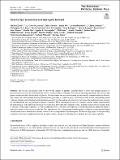| dc.contributor.author | Zevin, Michael | |
| dc.contributor.author | Jackson, Corey B. | |
| dc.contributor.author | Doctor, Zoheyr | |
| dc.contributor.author | Wu, Yunan | |
| dc.contributor.author | Østerlund, Carsten | |
| dc.contributor.author | Johnson, L. C. | |
| dc.contributor.author | Berry, Christopher P. L. | |
| dc.contributor.author | Crowston, Kevin | |
| dc.contributor.author | Coughlin, Scott B. | |
| dc.contributor.author | Kalogera, Vicky | |
| dc.contributor.author | Banagiri, Sharan | |
| dc.contributor.author | Davis, Derek | |
| dc.contributor.author | Glanzer, Jane | |
| dc.contributor.author | Hao, Renzhi | |
| dc.contributor.author | Katsaggelos, Aggelos K. | |
| dc.contributor.author | Patane, Oli | |
| dc.contributor.author | Sanchez, Jennifer | |
| dc.contributor.author | Smith, Joshua | |
| dc.contributor.author | Soni, Siddharth | |
| dc.contributor.author | Trouille, Laura | |
| dc.date.accessioned | 2024-02-05T16:22:23Z | |
| dc.date.available | 2024-02-05T16:22:23Z | |
| dc.date.issued | 2024-01-30 | |
| dc.identifier.uri | https://hdl.handle.net/1721.1/153459 | |
| dc.description.abstract | The Gravity Spy project aims to uncover the origins of glitches, transient bursts of noise that hamper analysis of gravitational-wave data. By using both the work of citizen-science volunteers and machine learning algorithms, the Gravity Spy project enables reliable classification of glitches. Citizen science and machine learning are intrinsically coupled within the Gravity Spy framework, with machine learning classifications providing a rapid first-pass classification of the dataset and enabling tiered volunteer training, and volunteer-based classifications verifying the machine classifications, bolstering the machine learning training set and identifying new morphological classes of glitches. These classifications are now routinely used in studies characterizing the performance of the LIGO gravitational-wave detectors. Providing the volunteers with a training framework that teaches them to classify a wide range of glitches, as well as additional tools to aid their investigations of interesting glitches, empowers them to make discoveries of new classes of glitches. This demonstrates that, when giving suitable support, volunteers can go beyond simple classification tasks to identify new features in data at a level comparable to domain experts. The Gravity Spy project is now providing volunteers with more complicated data that includes auxiliary monitors of the detector to identify the root cause of glitches. | en_US |
| dc.publisher | Springer Berlin Heidelberg | en_US |
| dc.relation.isversionof | https://doi.org/10.1140/epjp/s13360-023-04795-4 | en_US |
| dc.rights | Creative Commons Attribution | en_US |
| dc.rights.uri | https://creativecommons.org/licenses/by/4.0/ | en_US |
| dc.source | Springer Berlin Heidelberg | en_US |
| dc.title | Gravity Spy: lessons learned and a path forward | en_US |
| dc.type | Article | en_US |
| dc.identifier.citation | The European Physical Journal Plus. 2024 Jan 30;139(1):100 | en_US |
| dc.contributor.department | LIGO (Observatory : Massachusetts Institute of Technology) | |
| dc.identifier.mitlicense | PUBLISHER_CC | |
| dc.eprint.version | Final published version | en_US |
| dc.type.uri | http://purl.org/eprint/type/JournalArticle | en_US |
| eprint.status | http://purl.org/eprint/status/PeerReviewed | en_US |
| dc.date.updated | 2024-02-04T04:21:59Z | |
| dc.language.rfc3066 | en | |
| dc.rights.holder | The Author(s) | |
| dspace.embargo.terms | N | |
| dspace.date.submission | 2024-02-04T04:21:59Z | |
| mit.license | PUBLISHER_CC | |
| mit.metadata.status | Authority Work and Publication Information Needed | en_US |
